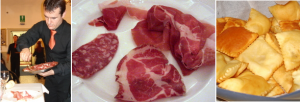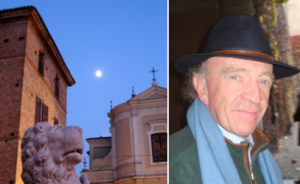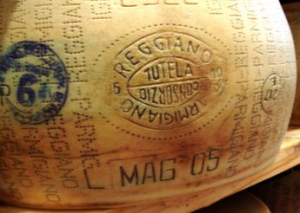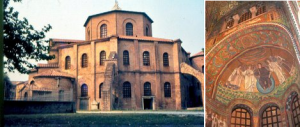Hamming it up in Parma
Parma, capital of, duh, Parma ham, of parmesan cheese, of theater and opera. Wine…not so much; it’s the simple, slightly fizzy red called Lambrusco, but, whaddya know, it goes great with Parma ham.
And go it does at the Corale G. Verdi, a century-old restaurant and music venue where dinner guests are treated to occasional operatic blasts by glee club members (think Seattle Mens Chorus). Prosciutto and other cured meats are served by a phalanx of cheerful waiters, and the chef , bringing out piping hot pillowcases of fried dough, slaps your hand if you’re crass enough to be nibbling plain bread. A six-course dinner gets pricey, but you can have just the salumi misti and the torta fritta for 13 euros, well under 20 bucks.
Looking up: a heavenly interlude
Don’t worry, Gran, they’re still feeding us! There’s the beautifully lean Culatello di Zibello that’s been cured on the moist banks of the Po; there’s the traditional Prosciutto from the hills behind Parma, where the Mediterranean air carries scents of chestnuts and pine trees; and the fragrant porcini mushrooms from the mountains. But before we go on to the next meal, a pause to savor the religious history of this place.

Ceiling of the dome in the Parma cathedral; ceiling of the baptistry Il Papa was on TV last night, in a live feed from the 17th century Blue Mosque in Istanbul. Looking upward, he would have seen many domes.
Here in Parma, though, the massive romanesque cathedral has but a single dome, painted in 16th century by Correggio with an awe-inspiring sense of upward movement in his spiral of angels. And just across the piazza, the imposing gothic baptistry has eight sides, decorations in Byzantine style, and another painted dome.
The unique, historic good fortune of Emilia Romagna is its agriculture: fertile plains, fresh water from Italy’s longest river, favorable winds, easy access to salt (don’t laugh; read Mark Kurlansky’s terrific book). How fortunate we are today that its medieval citizenry invested the quirky gift of prosperity in the creation of great art. Okay, a lot of it was bishops building the power of the Church. No matter: the lofty architecture of Parma’s piazza owes its very existence to the happy circumstances of the lowly pig.
Moon over Parma
Cold and damp, it’s been lately. Pale, watery afternoon sunshine gives way to fog creeping up from the mighty Po. Thermometer registers 40 but body feels like -10. Call it humidity chill. (Is this what a bottle of well-cellared wine feels like?) Anyway. Outside Parma, the castle of Rocca di Soragna, complete with living prince, full name Diophebo Mello Lupi di Soragna. (Nice guy, goes hunting with yellow lab retriever, leaves for heli-skiing trip in British Columbia next month.)
This cheese stands alone
In the grassy plain of the Po, between Piacenza and Bologna, a quarter million grass-fed cows on 5,000 dairy farms contribute their milk to 500 artisanal producers of a very specific cheese, Italy’s finest: Parmigiano – Reggiano.
In batches of 1,100 liters, the combined morning and afternoon milkings (the amount produced by some 40 bovines) is transformed: cream skimmed, casein starter and rennet added, curds cut into rice-sized granules, boiled for 10 minutes in a copper steam kettle under the watchful eye of a master craftsman, then drained, divided in two, wrapped in cheesecloth, formed in traditional, 100-lb. moulds, salted for three weeks, aged for a year, inspected and graded, then aged for another year or two. At the end of the process, the cheese emerges as genuine Parmigiano-Reggiano.
The best, stravecchio sells at the dairy for 13 euros a kilo, about $9 per pound. In restaurants here in Parma, the menu gives you the cheese’s full pedigree: name of dairy, month of production. The real thing, when you can find it in the States, is around $15. And is it ever worth it. Dense, crumbly, it isn’t sliced but stabbed into little pieces.
Nutty, fruity, sweet and despite the salt that helped create it, with a remarkable complexity and depth of flavor, it’s a treat on its own (with a dash of balsamic vinegar, perhaps) or grated over pasta (nothing like the packaged soap flakes sold as “Parmesan” by Kraft). Here and only here: the product of its unique place, always hand-made.
A couple of easy recipes follow. Also, in days to come, the fabulous mosaics of Ravenna and the surprising Jewish history of Ferrara.
Bright & shining
Wait until dark, then light a candle inside Ravenna’s Basilica of San Vitale: you’ll be dazzled, awe-struck. Byzantine architecture dating from the middle of the 6th century, its brilliant mosaics–including 25,000 pieces made with gold–virtually intact.
Then go for dinner. You might be served an appetizer of sformatino di squacquerone, bright-tasting and fresh from the oven, accompanied by a delightful, frizzante (slightly effervescent) Malvasia. Two equally satisfying aspects of Ravenna: serious art, traditional food.
Written By: Ronald Holden






